View current page
...more recent posts
Edward B. Rackley on those $100 laptops for 3rd World kids we've been hearing so much about:
I'm soon headed to northern Uganda to research violations against children by the Lord's Resistance Army and the Ugandan National Army. I'll keep one eye skyward for any falling laptops--although such spacejunk is already common in rural Africa. I used to work with Dinka pastoralists in Southern Sudan who decorated their cattle by hanging discarded CDs from their horns. The CDs were recovered from the trash pits of international NGOs working to improve the lives of southerners during the war with Khartoum. Of course they had no idea what the CDs were, other than round reflective disks once used by foreigners. What would the Dinka do with laptops? Maybe trap wild game in the mighty jaws of the hinge mechanism connecting keyboard and screen.On discussions of the laptop at Davos:
Their debates over how to solve the global 'digital divide' bear the mark of all starry-eyed social engineering endeavors, with the world's digitally illiterate providing a conveniently captive set of guinea pigs. Lack of food, water, education and safety for many in the developing world apparently matter little when you can throw a $100 laptop at the problem.

"Nicholas Negroponte of M.I.T. shows off his $100 laptop"--NY Times caption and photo.
2001 [counter-directional arrows] 2006
Jason Kottke: "Nasty Nets used CSS positioning to 'embed' one YouTube video into another. 'Be sure to hit "play" on both YouTubes.' Reminds me of the animated GIF mashups (link)."
Hello, content? Who cares about CSS positioning?
As Theodor Adorno described the work: "An exquisite and in some ways exquisitely awful play of symmetries. The 1968 'state of the art' trip sequence from 2001: A Space Odyssey, its widescreen magnificence reduced to YouTube size, serves as a continuously running background to a smaller YouTube nested within its boundaries. The foreground film consists of a simple but somewhat relentless montage of photos made by teenagers playing with basic iPhoto effects, while Queen chugs along on the soundtrack.
"The split screen, mirror image appears in both foreground and background: one limns a cleavage in space-time, expansive, landscape-embracing, the other barrages the viewer with portrait grotesqueries, cartoonish Francis Bacon-like horrors caused by flipping selected facial features. Yet there are 'crossover points' where the faces widen and flatten into topographic arrays and the Kubrick film jumps to contorted portrait closeups of Keir Dullea's agonized face.
"The background clip has pretentions to high culture with its doom-laden Ligeti score and references to Modernist abstraction yet it is ultimately still a mass market popcorn movie. The teens' use of iPhoto exploits the most readily available computer imaging gimmicks such as 'spherizing' but is actually superior in its quick, intuitive sense of play to the ponderous 'high art' uses of the exact same tools by artists such as Lucas Samaras. As above so below, art mirrors the street and vice versa."
Update: I changed the title of this post because it was fuX0ring my RSS feed. I really, really, really hate the inflexibility of RSS and wish people would just bookmark me like in the old days.

"Let's go take another look at The Year in the Internet 2006!"
I've been enjoying this music on the WFMU download page (scroll down) from "an obscure bootleg of German minimal synth stuff from 1979-1983 entitled Kassettentater (Cassette Offender)." Especially good is the first track "Steig Den Luis Trenker" by 4172. Any help from a German language speaker on the content (just a rough idea) would be appreciated. The wikipedia bio on Trenker, an Austrian-Italian film director, architect, and actor, is interesting:
His first contact with film came in 1921, in which he helped director Arnold Fanck on one of his mountain films. The main actor could not perform the stunts required, and so Trenker assumed the leading role. He gradually assumed more roles on set, and by 1928 was directing, writing and starring in his films. By this year he had abandoned his job as an architect to concentrate on art and married Hilde Bleichert, with whom he had four children.Update: Thanks to drx for explaining that the song is a response to "Tanz den Mussolini" by DAF. He says:
The main theme of Trenker's work was the idealization of connection with the homeland and pointing out the decadence of city life. This loosely played into the hands of Nazi propagandists, who seized upon the nationalistic elements of his work. However, Luis refused to allow his work to subverted as such and eventually moved to Rome to avoid further governmental pressure. This, though, was not to be and after a pair of documentary films Trenker returned to Bolzano to quit making movies.
After the war Trenker was accused of fascist opportunism but eventually the charges were dropped. In the mid 1950s he again able to make movies, though by 1965 he had switched mainly to the documentary form, focusing mainly upon the Austrian Tyrol.
[T]he arrangement and lyrics are nearly identical. Instead of Hitler and Mussolini and Jesus Christus, this song covers some (at the time of recording) contemporary Germans and Austrians. Like actors (Harald Juhnke), publishers (Axel Springer), sportsmen (Niki Lauda, Toni Sailer) etc ... some i cannot understand. Probably they are dead already. But the ones i recognize have been very important or still are. Only some have to do with right wing stuff, like Axel Springer. Others had plane crashes or were just terrible people on TV every day.
Instead of "Dance the Mussolini" we have verbs that go with things these people were famous for, like "drink the Harald Juhnke", coz he was an alcoholic.
All DAF fans can for sure enjoy this bootleg :)
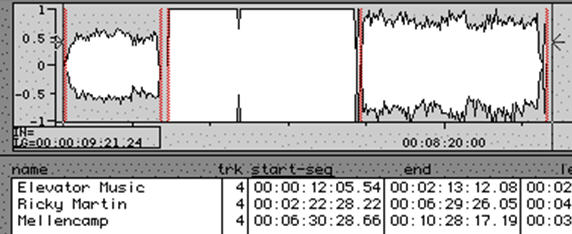
CD loudness comparison chart by Bob Katz. Edward R. Tufte would give this high marks for effective visual communication, plus it's funny. Sorry it's fuzzed out (drx, don't kill me)--the letters looked gimpy when I attempted an odd-number scale-up so Ph*t*sh*p had to be used.
"Song 15 (Nosebone)" [mp3 removed]
London, UK producer Brains has kindly remixed a couple of my tunes and encouraged me to pick up the pace a bit. This song is peppier (138 bpm) than the usual fare (90-120). It's done "live" in one take on that tangle of gear posted earlier.
Update: I will likely do another version with less of the high-pitched chirp-stabs.

When the U.S. President talks about American soldiers dying for "freedom," this is what he's referring to:
Iraq in Talks With Chevron, Exxon
Houston Chronicle
LONDON — Iraq is in negotiations with Chevron Corp. and Exxon Mobil Corp. to build a new $3 billion petrochemical facility, and is in talks with several other Western companies over industrial projects.
In an interview Thursday, Iraq's minister for industry and minerals Fowzi Hariri said the discussions with Chevron and Exxon began this week in Washington and are at an early stage.
"It will be one or the other company for this new facility, not both," he said. "We're hoping to have a (Memorandum of Understanding) in place by about July."
Hariri took his first trip to Washington early this week and met with several companies about industrial projects. The other leg of his trip took him to London, where he also met with a number of firms.
The minister, who has been in his post since last June, said the issue of security was a prominent feature of the discussions, given the sectarian conflict that has come to characterize Iraq over the past year. He said he emphasized to the companies that much of the violence has been in Baghdad. "What you see on the television is real ... but it's concentrated in the capital," said Hariri.
The discussions with the companies have been greatly aided by an Iraq foreign investment law that won final approval last October, he said.
Hariri said he hoped discussions with ABB Lummus, a unit of Swiss-Swedish electrical engineering company ABB Ltd., Dow Chemical Corp. and KBR Inc. over rehabilitating existing facilities would lead to tentative agreements by around March. "This is what we're hoping for but we will see," he said.
The contract with ABB Lummus could be worth $100 million, while Dow Chemical's contract could be $40 million to $50 million, the minister added. The contract forms for all the deals under discussion would include joint ventures.
While in the United States, the minister also held talks with the U.S. Geological Survey about performing a nationwide survey of Iraq's potential mineral base. He said he "had a good discussion" with the Export-Import Bank about possibly providing some of the financing for a nationwide survey to gauge Iraq's resources.
"We know we have iron ore and we think we have copper and probably gold," he said, adding that those opinions were based on old data.
Hariri plans to have discussions with General Electric Corp. over possible power turbine contracts and with General Motors Corp. over contracts for service vehicles, such as fire trucks and ambulances. The latter contract would be worth $80 million or less.
Over the next several years, the minister said Iraq would look to privatize all of state-owned industry, which number around 60 companies. He also said Asian companies were keen to enter discussions with the Iraqi government over industrial contracts.
Hariri said Iraq was also in discussions with San Francisco-based Bechtel Corp. over engineering contracts, but did not elaborate. The company recently said it was leaving Iraq after suffering through a spree of violence that killed 52 workers. The departure of the company served as another sobering reminder of how the carnage in Iraq has scrambled the United States' ambitions to rebuild the country.

Untitled (Lower My Bills), 2007, animated GIF. The actual, moving version is over on Nasty Nets, where I've been posting photos of Dr. Zizmor ads and other things of note. NN was recently included in "Professional Surfer,"* an online exhibit curated by Lauren Cornell for Rhizome.org.
Related: The Art of LowerMyBills.
Update, 2011: Rhizome changed the "Professional Surfer" link to http://archive.rhizome.org/exhibition/timeshares/professionalsurfer.php

"Song 14 (Dirty LFO)" [mp3 removed]
Update: A more stripped -down version of this: "Dirty LFO (Solo)" [2.6 MB .mp3]
Commentaries, commodities, copies,
appropriation, authorship, death-talk,
originality, ... these are for "heroes,"
hot dog boys and bubble gum chewers.
Elaine Sturtevant, 1987

artist unknown--see comments to previous post on perpetual motion and such. perpetual internet motion?
update: i got tired of looking at the GIF that was here and moved it below the fold.


Images found here while searching for perpetum (sic) on Google Images.
When Curators Spew Ad Copy
An excerpt from a UK Times article today about the release of Destino, the aborted Dali/Disney film collaboration "reconstructed from more than 100 storyboards, drawings and paintings...created over nine months in 1945 and 1946" (thx bill):
Matthew Gale, the Tate's curator of the exhibition, said that [Dali and Disney] understood each other, partly because Disney’s own work was surreal. He added: "If you look at the things that happen in Sleeping Beauty or Snow White, there are surreal instances."Somehow I don't think Andre Breton had Snow White in mind when speaking of the mind-shattering, politically transgressive power of the unbridled sexual unconscious. Dali and Disney understood each other because they spoke the common language of $$$$$$. I'm sure the film's eminently watchable, but (a) it is a pure simulacrum since the creators are long dead (akin to posthumously-reconstituted Jimi Hendrix/John McLaughlin jams) and (b) it's kitsch--the "sampled" authors had their early moments but they were fundamentally schlockmeisters as they got older.
R. Murray Schafer's 1977 book The Soundscape is highly recommended; as Bernard Krause said on amazon.com: "the narrative still reads like a contemporary novel." Just as Patrick Suskind in Perfume sensitizes us to the world of smells we never knew existed, Schafer engulfs the reader with a wealth of sonic details (without filtering them through the mind of a maniac). Here are some political conclusions he reaches based on the book's careful study of aural history and geography:
The acoustic community eventually found itself in collision with the spatial community, as evidenced by numerous noise abatement by-laws. This conflict is also recorded in the decline of Christianity when the parish shrank under the bombardment of traffic noise, just as Islam waned when it became necessary to hang loudspeakers on the minarets, and the age of Goethe's humanism passed when the watchman's voice no longer reached all the inhabitants of the city-state of Weimar. [...]He is proposing to stand society on its ear (so to speak).
Modern man continues this retreat indoors to avoid the canceled environments of outdoor life. In the lo-fi soundscape of the contemporary megalopolis, acoustic definitions are harder to perceive. The sound output of the police siren (100+ dBA) may have surpassed the faltering voice of the church bell (80+ dBA), but such an attempt to produce a new order by sheer might is today proving anachronistic, as increased anomie and social disintregration prove. Today, when the slop and spawn of the megalopolis invite a multiplication of sonic jabberware, the task of the acoustic designer in sorting out the mess and placing society again in a humanistic framework is no less difficult than that of the urbanologist and planner, but it is equally necessary. The problem of redefining the acoustic community may involve the establishment of zoning regulations; but to limit it to this, as is common today, is to mistake the trajectories of the soundscape for the sight lines of the landscape. Only when the outsweep and interpenetration of sonic profiles is known and accepted as the operative reality will acoustic zoning rise to the level of an intelligent undertaking.
It seems appropriate to mention here a passage from Daniel Albright's book Untwisting the Serpent: Modernism in Music, Literature, and Other Arts, which also gets at the antagonism of the visual and aural worlds, less on the political side than the poetic:
In his remarkable centennial essay on Beethoven (1870), Wagner (partly following Schopenhauer) divided human experience into a light world--a domain defined by the eye, vigilant, alert, prosaic--and a sound world--a domain defined by the ear, inward-turned, unconscious, so far outside the boundaries of time and space as to permit telepathy and prophecy. [Lengthy Wagner quote omitted] Music then, is a sort of dreaming of the ear; an endless, subtly readjusting refinement of a shriek.
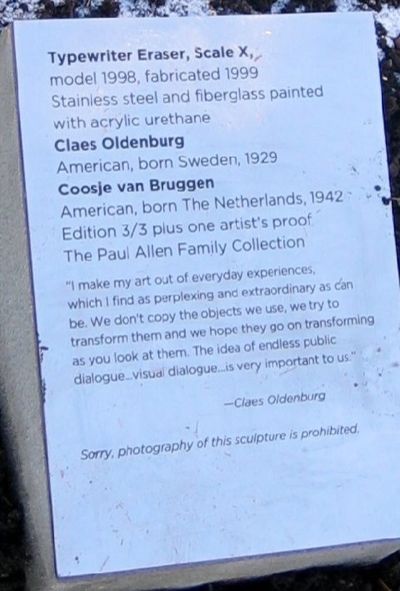
"But officer, I wasn't photographing the eraser sculpture, I was transforming it."
Photo from The Stranger, via T.Whid, who has been discussing the issue of artists' asserting a copyright interest in public sculpture. He wonders if "perhaps it's the city officials negotiating the sales of these things need some education? They should make certain that they get the rights for the citizens to photograph these pieces. If the artists are going to be so greedy, it’s seems the only alternative." That's absolutely right. Or in the case of the notorious Anish Kapoor mirrored bean, negotiating the acceptance of a "gift" from a major corporation.
New York Times columnist Tom Friedman writing in his "globalist" book, The Lexus and the Olive Tree: "The hidden hand of the market will never work without a hidden fist. McDonald's cannot flourish without McDonnell Douglas. And the hidden fist that keeps the world safe for Silicon Valley's technologies to flourish is called the U.S. Army, Air Force, Navy and Marine Corps." First of all, with 700 military bases around the world no one can seriously call the fist "hidden." But who knew people around the globe were eating KFC and watching Die Hard at gunpoint? Friedman has remarkable insight. At least this quote is more honestly cynical than his famous "No country with a McDonald's has ever gone to war with another country with a McDonald's." (McDonnell Douglas quote via Daily Kos)

A live drawing demonstration by yours truly on YouTube. It's 7 min., 18 secs. Watch and learn. Thanks to Guthrie for compressing and uploading this--I still don't have a YouTube account. But it's the perfect place to teach folks how to draw good.
Update: jmb spotted the timeless "Antler Fight" on the side of my YouTube page. Bertolucci, eat your heart out.
Juan Cole, on the news that VP Cheney blew off overtures from Iranian moderates in 2003:
Fascism depends on the creation of straw man enemies said to be dire threats to the Homeland. Iran is a poor weak third world country and poses no threat to the US. It hasn't aggressively invaded another country for over a century. But Cheney needs Iran to substitute for the old Soviet Union, otherwise how could he get you to agree to let him listen in on your telephone calls without a warrant, or let him torture people?

Infinite Smile (view in Quicktime here), by the artist duo MTAA (M.River & T.Whid Art Associates), made its gallery debut last night in an elegantly appointed group show at Bryce Wolkowitz. A video of the artists holding smiles for a stretch of several agonizing minutes is sped up, then run forwards and backwards to make a continuous loop. The gallery projection is large and seamless and the viewer is transfixed helplessly before this techno-tableau of painful good intentions. The time-alterations give the subjects a twitchy, amphetamine-addled look: they might to be holding poses for some future dystopian hologram ID gone all glitchy due to budget cuts in the security ministry.
Interesting historical show at Greene Naftali gallery opened last night: paintings and film by Tony Conrad, a cult figure who performed with La Monte Young, John Cale, and Faust in the '60s/early 70s. As the story has it, he invited people to a '70s film screening and instead of the avant garde Stan Brakhage-like art cinema they were expecting he hung a group of abstract paintings around the room the approximate height and orientation of film screens. The paintings had heavy brushy black outlines and resembled empty cartoon panels. These non-cloying pastel trichromes were painted on heavy paper and pushpinned to the wall; crimped and decayed after 30 years in the artists' attic, the same "screens" now fill the gallery and are extremely funky.
It's possible that Conrad invented "New Image Painting" with this show--that is, the injection of pictographic imagery into the uninflected language of minimalism as later, more famously practiced by Susan Rothenberg, Robert Moskowitz, and Jennifer Bartlett--and he should get props!
A real treat was seeing a Conrad film projected on one of the columns of the gallery. Seizure-inducing op art abstraction consisting of stroboscopic layers of horizontal and vertical bands triggering optical colors on the retina, all the stranger for being on scratchy, browning, aged film stock. Accompanied by a recording of John Cale's and Terry Riley's "Ides of March" from the Church of Anthrax album. This music--again, a cult fave in the music world--was played during the film's original screening, which I'm guessing must have been around '70-'71. Cale was Conrad's roommate at the time, I'm told. Slightly off-topic, I've read that the minimal-minded Riley strenuously objected to the energetic drum kit Cale dubbed onto this two-piano work.
Thanks to Greene Naftali for the time travel.
Update: According to Jeff S the film we saw was "Straight and Narrow," which Conrad made with his wife Beverly.

"Song 13 (Quatrains)" [mp3 removed]
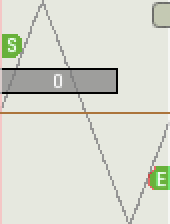
"Song 12 (Simple Waveforms)" [mp3 removed]
A few thoughts on science fiction:
I'm embarrassed to say I don't think about the future much, other than serious unease about what we're doing to the planet and what steps we could take to lower our "carbon footprints." The writing here is fixated on a relentless present, which makes it hard even to look back at the past of what's already been said. (Although no one could be as amnesiac as the hapless Kevin Drum, who claims not to remember what lefty bloggers were saying before the Iraq War started.)
I still read a lot of science fiction but I think of it as travelling laterally in time, to parallel universes where technology has had this or that effect, or as a Swiftian satire of our moment. Or pure escape into a visionary world. I'm not apologetic about the latter, as long as the "visions" aren't too much about simple, obvious adolescent wish fullfillment ("If I could fly I'd show them!")
The film critic Raymond Durgnat once talked about the "mute poetry of the commercial cinema," such as a poignant shot of items in a display window in an otherwise awful film. That's what I'm most interested in in sf--the poetic content of imagining the future, which speaks to our time as opposed to just reiterating past writing conventions (e.g., having a character using a computer in a present day novel that is otherwise 19th Century in its structural particulars).
Retail demographics.
Hadn't been in the Midtown stores I used to haunt in a while and noted some changes:
1. The sequencer/groovebox listening room at Sam Ash is gone. There are still a couple of Akai sampling workstations you can demo in the main keyboard room, and two Korg Electribes locked in a glass case there. It looks like software has been expanded but it's hard to say--the boxes are spread around the main room incoherently.
2. The bookstore at the Virgin Megastore has been cut back in floor area. The section outside the cafe formerly devoted to new releases and graphic novels is now T-shirts and I Heart NY tourist crap. Inside the bookstore, shelves have been removed to accommodate a new store area: TV shows on DVD. Science fiction books are down to about 3 shelves, mostly novelizations of movies and TV series.
3. The Loews threatre inside the Megastore, which used to be "state of the art" in the mid '90s, fell on hard times and is now closed. They are using the lobby to store DVD shelving units.
Looks like I'm not the only one spending all my time online.
Science fiction diary. Spent a few days commandeered by the paranoid, smarter-than-thou mind of A. E. Van Vogt; after finishing The War Against the Rull, the Weapon Shops cycle, and Voyage of the Space Beagle I felt like I'd been let out of prison. Someone (David Pringle?) described his books as "visionary but slapdash" and that's true but the author has this quality of certainty about the futuristic folderol that's more than a little scary. He's constantly talking about "superior systems of thought" that are mostly just mind control techniques. You can see why he embraced Dianetics in the '50s (he later unembraced it)--it would appeal to the brain that conceived Nexialism in the late '30s (a cross disciplinary hybrid of all sciences), built a series of novels on non-Aristotelian logic (I didn't like The World of Null-A much), or conceived the "guns against the government" libertarian credo of the Weapon Shops (a scheme dependent on the machinations of an immortal superman working behind the scenes).
Pringle, in his seminal Science Fiction: The 100 Best Novels, considers Charles Harness' The Paradox Men to be the best book Van Vogt never wrote. It, and the later tome The Ring of Ritornel combine some of Van Vogt's swashbuckling medievalism (both Harness novels take place in a future feudal society) and wild leaps of imagination, but are much more satisfying and conceptually tight, and you don't intermittently wonder if the author is crazy. The stories have posthuman themes that anticipate cyberpunk and a strain of quantum mysticism that later comes to full flower in the writings of A. A. Attanasio. Paradox has a character called the "Meganet Mind," a horribly disfigured former circus freak who spends all his time plugged into a vast computerized library (this was written in 1953), and Ritornel features a former poet laureate whose brain is removed and wired into a computer called the Rimor, which dispenses verse and song for a depressive Emperor.
The "disembodied identity" is a constant of Attanasio's. In Radix his Voors are aliens feeding on the energy spraying from a collapsar who eventually become trapped in human bodies, living out their years as vampiric soul-eaters. In Solis the main character is the brain of a man who has himself frozen for posterity only to wake up as a machine component. In several AAA books the dead continue to live as gradually-dwindling packets of photons. Harness presages all this with the Rimor and also his characters in Ritornel who go into "the Deep" between galaxies and reemerge as antimatter beings, walking among normal humans by means of matter-protecting skin prosthetics. And speaking of the space between galaxies, to bring this full circle to Van Vogt, there is nothing quite like his image of a red horned devil creature hovering in that trackless void only to be awakened after aeons by a passing earth vessel. This is the basis of the plot that became the movie Alien--the creature is taken into the ship and begins laying eggs in the crewmembers' bodies.

"Song 11 (Magic Fingers)" [mp3 removed]
Deleted background instruments in photo inspired by this post [link removed] on "unwitting Baldessaris."
Hacking vs Defaults, an argument about types of Internet art in table form by Guthrie Lonergan. The blog you are reading is proud, yet...humble to be included in the scheme. For more Defaults than you can possibly consume at one sitting see the Year in the Internet 2006, which includes Lonergan as curator and also Travis Hallenbeck, whose exquisite taste in the Internet is a constant inspiration.
For example, handmade plastic models of Rick Wakeman's keyboards, this Google video documenting a slow-playing cassette deck, and these great, perfectly centered photos of food.
 The Year
The YearIn The
Internet
2006
"We asked some people what their top ten links of the year were for 2006. This is what they said."
- Michael Bell-Smith & Cory Arcangel
The Year in the Internet 2005

"Song 10 (MG)" [mp3 removed]
jimpunk: "Buckyball Bob" [179 KB Quicktime .mov] (1.5 second loop)
originally here as a downloadable .m4v for those little white players that people have.
(the buckyball is by me.)
An excerpt from More Brilliant than the Sun, a 1998 book on music by Kodwo Eshun, was posted on this blog six years ago in March. Here it is again, and it will be reposted yet again in 2013, that's how much I like it:
There are no drum-machines, only rhythm synthesizers programming new intensities from white noise, frequencies, waveforms, altering sampled drum sounds into unrecognizable pitches. The drum-machine has never sounded like drums because it isn't percussion: it's electronic current, synthetic percussion, syncussion. The sampler is at first termed an "emulator," as if it does nothing but imitate existing sounds. Calling the rhythm synthesizer a drum-machine is yet one more example of [r]earview hearing. Every time decelerated media writes about snares, hihats, kickdrums, it faithfully hears backwards. Electro [music] ignores this vain hope of emulating drums, and instead programs rhythms from electricity, rhythmatic intensities which are unrecognizable as drums. There are no snares--just waveforms being altered. There are no bass drums---just attack velocities.Somehow the passion and insight of this writing in response to music that was revolutionary ten, fifteen, twenty years ago, ought to be held onto in the face of overwhelming excess production--the microchip revolution that has probably resulted in more djs than listeners, as represented by the surfeit of grooveboxes in stores and on eBay. What if there were only a few of these left in the world? Someone would be hacking the chips for sure once the factory-intended "unlimited sonic possibilities" had run out. When writing music for machines like this--and it's a hoot, I recommend it, they're cheap used, kind of a latter day harmonica or skiffle pole--I sometimes envision a jaded, overworked "holy man" of a post-apocalyptic tribe that has somehow preserved one of these rarities (plus a generator, amp, and speakers). The tribe engineer is constantly tweaking it, and together they are responsible for keeping people amused and "up" at all events requiring shamanic jubilation such as weddings, funerals, and war rallies.
John McCain defends Bush's strategy. Contrary to media hype, John McCain is not a moderate Republican. He is a war hawk, and wants to kill American soldiers to prop up Bush's vanity and bad judgment.
more
"Clip City" [mp3 removed]
I have posted this tune several times--it's kind of my "learner."
This version I'm calling self-"mastered" because I used some compression and reverb plug-ins to give it a fuller sound. I finally took a minute to learn how to use Send effects in Cubase, so I could automate a "wet/dry" parameter on the Sidstation track. Doing so converted that track from mono to stereo (sort of) and added reverb that comes and goes while it's playing. Also, I now know to put the compression "limiter" setting at the Master gain so the sum of all three tracks never goes above -.2 db. D'oh. Each track (drums, Mutated drums, and Sid) has parametric compression that both compresses it and boosts EQ on the mid-level frequencies. [/music diary]

"Song 9 (Wipeout)" [mp3 removed]

image of work by Ralston Crawford, a lesser-known Precisionist
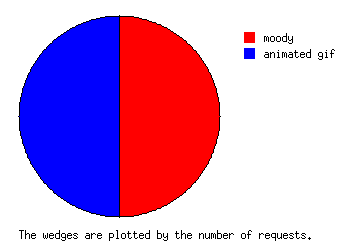
"Liberal hawks" say things that make the skin crawl. Steve Gilliard quoted this, from The New Republic:
Maybe these people are right that withdrawal is necessary, but I don't think we should underestimate the consequences of it. By consequences, I don't mean anything as concrete as the prospects of a possible Al Qaeda sanctuary in Anbar provence or the abandonment of thousands of Iraqis to certain death. I'm talking about something more nebulous: what are the consequences of America losing a war--which is, after all, what withdrawal will mean? What will it do to our position in the world? What will it do to the national psyche? And what will it do to the people who fought in that war? (Yes, they'll be out of harm's way, but they'll also be left to conclude that all their efforts--and their sacrifices--were in vain.)Translation: "It's our oil now."
Granted, these are all things Bush and supporters of the war should have thought more about before we invaded Iraq; but now that we're there--and we're all so sick of this war that many of us want to get out--we can't afford to ignore them again. The question about the surge [escalation --tm] to me is: are the consequences of defeat so dire that it's worth one final attempt to avoid it?
I don't know the answer to that. I'll watch Bush's speech tomorrow night; I'll listen to what Kennedy and Biden and any other Democrats have to say in response; and I'll try to come to a conclusion. Maybe that's not a position of "moral seriousness." But I can't help but thinking that it was certainty--on the part of supporters of the war--that got us into this mess. And I'd hate for such certainty--on the part of opponents of the war (some of whom were actually certain in their support of the war not that long ago)--to get us into another one.
--Jason Zengerle
New stiffies. If I was a "photographer" I'd just throw away my gear. Be sure to click on images for the "easter eggs."
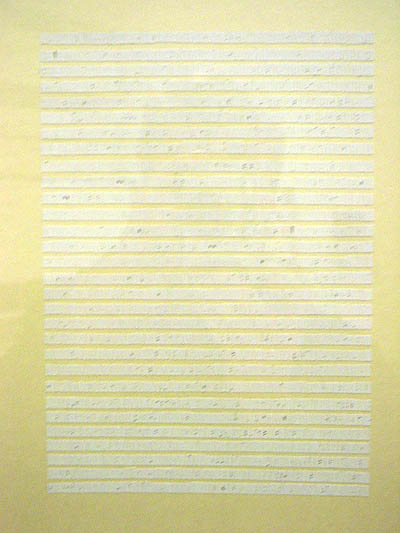
From the comments, some back and forth about Cody Trepte's recent show at NYU is below. To recap, it included three types of work: "binary cross stitches," an essay by pioneering computer scientist and codebreaker Alan Turing with everything but the 1s and 0s removed, and collages consisting of the cut-out negative spaces (spaces between words) from another Turing essay.
t.m. (from the original post) The show is a non-standard take on "computer art" in the gallery context. The formal vocabulary is reductive (or accumulative) minimalism a la Yayoi Kusama's airmail stamp paintings, and while the subject matter is the language of both the computer and the computer scientist, it's treated not in a literal way but rather as an absence, or anti-content. As the press release explains, Turing was gay and accused in the not so swinging '50s of "acts of gross indecency." His "sentence" was an "experimental hormone therapy" consisting of estrogen injections to "reduce the libido." He died a couple of years later, apparently a suicide, but with questions lingering. Trepte's work is thus not the typical Buzz Lightyear computer-fetish celebration but rather an examination of the repressed, fragile, elegiac back story to the "machine that's changed our lives."
p.d. tom im struggling with this stuff a bit...
cos i want to see computer art that isn't exhibited on a computer, and while this isn't computer art i dunno it seems superficial. with a process like this, why mess with turing as a subject?? to me it's arbitrary output is completely at odds with turing's work - an extremely insightful approach into the nature of numbers with [in his mind] applications towards the understanding and hopeful emulation of human consciousness.
maybe it's an idol worshipping thing cos to me turing is pretty much the Biggest Playa In Da Game and anything made about him would probably seem like it hasn't done enough. but in this case i feel like i wouldn't gain anything from seeing the work and much of it [according to the press release] actually seems to misunderstand its own subject matter.
btw i think he did dream in code: i've read that turing was comfortable doing base-32 arithmetic in his head. talk about a nerd!
t.m. I'm reminded of the joke about the old man in the powdered wig found in Beethoven's crypt carefully erasing musical scores. "What are you doing in here?" someone said. "Decomposing," he said.
But seriously...
There's 2 bodies of work here that kind of get smeared together. The cross stitches ask us to look at code as pure form and are not particularly "deconstructive." The erased texts are meant as a kind of protest mingled with process art and are also pretty seductive as objects.
I usually gripe about art that relies on a back story to be complete but in this case I'll give the artist his "repressed history of computing." John Nash was also gay, or bi, but you'd never know it from A Beautiful Mind, the movie. It's freakin Russell Crowe and his wife is Jennifer Connelly!
I'm for this show because Turing was all about meaning and look where his talent got him. Compulsory hormone treatments! If someone wants to highlight his texts in a combination fan tribute and act of negation (a la Rauschenberg's erased de Kooning drawing), I think there's room for that.
The peripheral stuff of computing, the things on paper, the markings, have their own presence and constitute a kind of mute, parallel language that an artist can illuminate for the rest of us. A bit like JG Ballard calling corporate memos and charts the true literature of our age.
I guess I'm saying there's different ways to pay homage to Turing. But it's true his virtues are largely left out.
p.d. jesus - who let the dogs out on the beethoven punchline? that was ripe. more jokes AND paintings of american mammals in the future please!
gotcha with the homage thing, i guess what im saying is i find the back story - creative guy who's repressed homosexuality got him killed [sickening as it sounds to non-Republicans] - historically a bit common. i think his theoretical ideas, ideas that have little to do with binary numbers per se, are far more worthy of inspection through art practice especially since they are still little understood by most artists who use modern day Turing-complete machines [i.e. every computer on the planet].
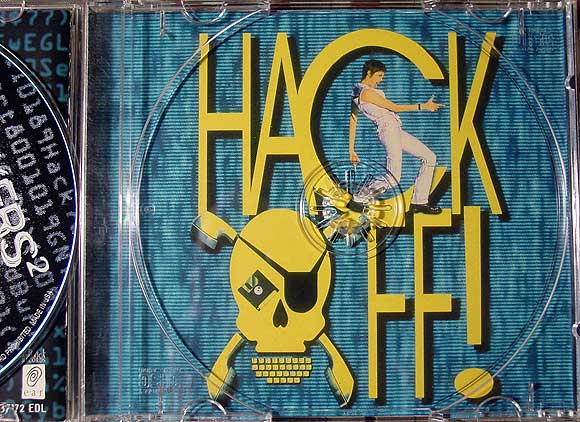
more
This tepid statement in Newsweek by Barack Obama, the supposed Hope of 2008, casting doubt that the Democrats can (will?) do anything about the coming Iraq escalation, is "discouraging," as Matt Stoller of MyDD understatedly puts it :
Before Barack Obama was a senator, he opposed the war in Iraq. Now that he is one, he says that sending more troops would be "a mistake that compounds the president's original mistake." But don't expect Obama--or most other Dems--to try to block George W. Bush when he asks Congress in the coming weeks for another billion-dollar bundle for the war. The party won't deny the funds, and may not even try to attach conditions to them. Obama made that clear last week when I saw him in his office, a sunny space filled with portraits of Thurgood Marshall, Abraham Lincoln, Mohandas Gandhi and Muhammad Ali. "To anticipate your question," said the Harvard-trained lawyer, "is Congress going to be willing to exercise its control over the purse strings to affect White House policy? I am doubtful that that is something we are willing to do in the first year."We need to call Obama's office and remind him that people outside Washington DC do not support the war. One reason to be discouraged is it does indeed, appear to be "all about the oil," according to this article in the The Independent:
[...]
Even as they decried the "surge" and declared that it is "time to bring the war to a close," Democrats offered reasons for staying out of Bush's way. Obama took the safest ground. "I cannot in good conscience," he said, "cut off funding for our troops that are already there." He and others will insist that future requests be included in the regular budget. Sen. Joe Biden, whose Foreign Relations Committee will launch hearings on the war this week, said that Congress's role is simply too limited to be effective. "It's all about the separation of powers," he said. Last month he told Bush: "This is your war, Mr. President, and there's nothing we can do to stop you."
Iraq's massive oil reserves, the third-largest in the world, are about to be thrown open for large-scale exploitation by Western oil companies under a controversial law which is expected to come before the Iraqi parliament within days.Yet the companies still have to find a way to extract the oil without getting their employees killed. Recall that Bechtel recently decided to pull out of Iraq after losing 52 people on the payroll. Bush's pathetic plans for escalation aren't enough, he's just hoping and praying it will work, while cowardly legislators such as Obama go along with him.
The US government has been involved in drawing up the law, a draft of which has been seen by The Independent on Sunday. It would give big oil companies such as BP, Shell and Exxon 30-year contracts to extract Iraqi crude and allow the first large-scale operation of foreign oil interests in the country since the industry was nationalised in 1972.
The huge potential prizes for Western firms will give ammunition to critics who say the Iraq war was fought for oil. They point to statements such as one from Vice-President Dick Cheney, who said in 1999, while he was still chief executive of the oil services company Halliburton, that the world would need an additional 50 million barrels of oil a day by 2010. "So where is the oil going to come from?... The Middle East, with two-thirds of the world's oil and the lowest cost, is still where the prize ultimately lies," he said.
Oil industry executives and analysts say the law, which would permit Western companies to pocket up to three-quarters of profits in the early years, is the only way to get Iraq's oil industry back on its feet after years of sanctions, war and loss of expertise. But it will operate through "production-sharing agreements" (or PSAs) which are highly unusual in the Middle East, where the oil industry in Saudi Arabia and Iran, the world's two largest producers, is state controlled.
 |
 |
 |
 |
 |
 |
 |
 |
 |
mark posted this in the comments.
Another, time delayed version by Damon Zucconi is here.
"Slow Robollywood" [mp3 removed]
To be played with the above spirals (either version). If you have tabs you can make your own YTMND.
Or you can just listen to it (or not).


"RingMod Plus Beats" [mp3 removed]
The two previous sound files combined, one after the other, with a reprise of "RingMod" on the final note.
The link was broken...for 18 hours. *moan* Thanks, Thor.
"Beats (Song 8)" [mp3 removed]
"Ring Modulation Demo" [mp3 removed]



Some photos I took at Cody Trepte's show (for Alan Turing), at NYU/Tisch School of the Arts' Gulf & Western Gallery, 721 Broadway. More about the show is here. At the top is a "binary cross stitch" similar to the one Trepte had in the Infinite Fill Show a while back. The middle image is an essay by pioneering computer scientist and codebreaker Turing with everything but the 1s and 0s removed (detail of a 33 page installation). The bottom image, another detail, is the negative space (spaces between words) in another Turing essay. The show is a non-standard take on "computer art" in the gallery context. The formal vocabulary is reductive (or accumulative) minimalism a la Yayoi Kusama's airmail stamp paintings, and while the subject matter is the language of both the computer and the computer scientist, it's treated not in a literal way but rather as an absence, or anti-content. As the press release explains, Turing was gay and accused in the not so swinging '50s of "acts of gross indecency." His "sentence" was an "experimental hormone therapy" consisting of estrogen injections to "reduce the libido." He died a couple of years later, apparently a suicide, but with questions lingering. Trepte's work is thus not the typical Buzz Lightyear computer-fetish celebration but rather an examination of the repressed, fragile, elegiac back story to the "machine that's changed our lives."
The exhibition's up through Saturday, Jan. 6. Gallery hours are 10am through 7pm weekdays, and noon to 5pm on Saturdays.
So, art in Miami 2006: a brief recap. It was this:
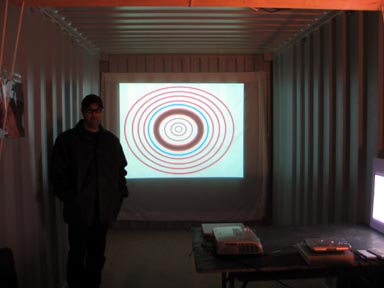
versus this:

(Apologies to Paddy Johnson for the polemical use of her photos. The point is that the small, scurrying mammals of the New Art were defiantly underfoot as the dinosaurs munched their last wads of eucalyptus. Or put another way, that the starship Voyager navigated through Borg Space despite the latter's overwhelming hegemonic force. Also, thanks to Johnson for including this blog and my artMovingProjects show in her 2006 best of the web wrap-up. She's one of that rare tribe of artist/critics willing to wade in and critique both the gallery world and the web world, or perhaps attempt to knock their mutton heads together.)
(Also check out her worst of the web '06, which includes such deserving topics as Banksy, Lonelygirl15, and a certain artnet writer who will never be mentioned by name here.)

artist unknown - GIF enlarged X 10
update: non-fuzzy (preferred) version - 425 KB
"Subharmonic Duo" [mp3 removed]
The piano parts in the previous tune were adapted for bass and two intertwining lead synth parts. I gave the piano piece a new name since it's closer to this piece than its predecessor. The rhythm parts were done with a hardware sequencer triggering both itself and tuned drum sounds with long decays on an analog drum machine. The '70s-synth-plus-techno vibe is an homage to Keith Emerson's film scores of the mid '80s (for anime and live action) that I still listen to quite a bit.

"Subharmonic Duo" (Piano) [mp3 removed]
Kind of a slow baroque modernist blues composition for piano, using the same notes as "Subharmonic Duo" minus the beats. The score above is an except near the end. (The title has been changed.)
"Dyspeptic Bass" [mp3 removed]
I spent the holidays working on songs and finally sat down with the manual and learned to use a hardware sequencer. I originally had the idea I would write all my material in the computer but someone on a chatboard I look at described the Electribe R-1 mkii as a "sketchbook" for rhythmic ideas and that idea appealed. (I got one a while back--they're pretty cheap--but had mainly been using it as a tone generator and a source of MIDI to mangle.) Of course the sketches can be recorded as audio or MIDI and developed further in the computer. The song above uses one of my first "drawings"--I kept the rhythm simple and put most of my energy into a kind of extended slow motion prog solo played on a different instrument, a software synth. [/music diary]
Update: this is the same basic melody as "Subharmonic Duo" but I called it "Dyspeptic Bass" because the synthesizer sounds gastronomically challenged. Maybe it's time for a Pink Floyd parody called "Gastronomy Domine."
In the comments to the previous post where I was complaining about the emphasis on timbre (musical sound or texture) in a recent New York Times story, p.d. reminds me that changes in timbre are the creative engine behind, like, all my favorite music (techno, hiphop, and so forth). He tells a great story about "Berry Gordy making the engineers build a radio transmitter and everyone heading out into the car to check how the motown test masters sounded...and remix, re-eq, recut, and test, etc...for the whole day because he knew if it didn't sound 'right' on the radio it wouldn't sell." p.d. points out how many current hiphop hits have built on such sonic refinements, from Motown right up through '90s drum and bass experiments, turning them into main attraction.
All true, but I don't think the sound scientist I was hectoring, Daniel Levitin, was talking about artists who consciously base their music on equalization or synth textures, a la the Detroit techno guys. He means monster hits, which I maintain rely as much on the marketing of personality and yes, old fashioned musical hooks. A good case in point was Cher's "Believe," to which the Times devoted an anatomy-of-a-chart-topper story several years ago. It was quite funny: Cher came off as the grumpy CEO of her corporate musical enterprise, complaining at development meetings to the teams that had various parts of the song parceled out to them. Seems they had the verses in the pipeline for six years but the chorus was eluding them (or maybe the reverse). She admonished one team to "go out and get more pain in their lives" to develop an effective hook. Someone had some weak lines and tried them with the vocoder and the rest is musical history. So, yes, timbre put the song over the top but the hit also resulted from nuts and bolts Tin Pan Alley songwriting. The acoustic scientist Levitin has discovered an interesting fact about current music but is announcing it as a principle. And no offense to anyone in a lab about the dig in the last post--my point is mainly that art is its own kind of rocket science but journalists love to dumb it down by reducing it to something quantifiable.
One should always be leery when scientists attempt arts criticism. The New York Times is not leery--it eats it up, witness all the stories about fractal analysis of Pollock paintings. Yesterday it ran an article about Daniel Levitin, a big time pop music producer who pulled out of the game in the early '80s and became an acoustic scientist. Check out this line of argument:
The subtlest reason that pop music is so flavorful to our brains is that it relies so strongly on timbre. Timbre is a peculiar blend of tones in any sound; it is why a tuba sounds so different from a flute even when they are playing the same melody in the same key. Popular performers or groups, Dr. Levitin argued, are pleasing not because of any particular virtuosity, but because they create an overall timbre that remains consistent from song to song. That quality explains why, for example, I could identify even a single note of Elton John’s “Benny and the Jets.”I believe it was the Beatles' manager Brian Epstein who had the industry visions based on the boys' looks, pop hook writing ability, stage energy and the like. After their breakthrough to larger fame Pete Townshend was still calling the production of their tracks "flippin' lousy" (the '60s TV interview where he says that is one of the funnier moments in The Kids Are Alright). As for being able to recognize a piano note from "Benny and Jets," who would want to? After the popular musical creativity of groups such the Jimi Hendrix Experience and the Doors, "Benny" was pure retrograde fluff. Levitin's idea that musical fame is based on timbre (or the continuity thereof from song to song) is the kind of cynicism that supposedly drove him out of the music biz years ago. As for the success of Elton John, that can be attributed to marketing and the burnout of '60s music rather than "timbre" (as long as we're being cynical).
“Nobody else’s piano sounds quite like that,” he said, referring to Mr. John. “Pop musicians compose with timbre. Pitch and harmony are becoming less important.”
Dr. Levitin dragged me over to a lab computer to show me what he was talking about. “Listen to this,” he said, and played an MP3. It was pretty awful: a poorly recorded, nasal-sounding British band performing, for some reason, a Spanish-themed ballad.
Dr. Levitin grinned. “That,” he said, “is the original demo tape of the Beatles. It was rejected by every record company. And you can see why. To you and me it sounds terrible. But George Martin heard this and thought, ‘Oh yeah, I can imagine a multibillion-dollar industry built on this.’
“Now that’s musical genius.”
Happy New Year.
Acen - Trip II the Moon [YouTube]
(I like the bouncing balls and spinning discs in this early 90s breakbeat 'ardkore vid. And the stop motion centipede that twirls into a dymaxion cocoon and emerges as a helicopter bug. The claymation alien repeatedly running toward the screen makes me think I'm losing my mind. And the music is sublime.)
Thanks, Jonathan! More soon.
MRiver's "CYA" end of the year recap is here. I greatly appreciate the mention of my artMovingProjects show in the Nerdz Rising '06 category. End of the year selections by Rick Silva and bloggy are also published on the MTAA blog.
